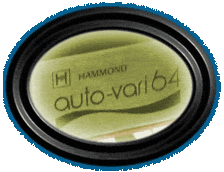Hammond Auto-Vari 64
 Purchased in the late autumn of 2000,
this impressive device immediately became SHotQ's main drummer (due to
its age and physical size). Auto-Vari 64 is a rhythm box, designed in 1973.
It's almost a meter wide, intended to sit on top of an organ and deliver
tasty rhythmic accompaniment to the tuxedoed organist. The flat top of the
elegant wooden cabinet is well suited for highball glasses (coasters required)
or a smaller synthesizer.
Purchased in the late autumn of 2000,
this impressive device immediately became SHotQ's main drummer (due to
its age and physical size). Auto-Vari 64 is a rhythm box, designed in 1973.
It's almost a meter wide, intended to sit on top of an organ and deliver
tasty rhythmic accompaniment to the tuxedoed organist. The flat top of the
elegant wooden cabinet is well suited for highball glasses (coasters required)
or a smaller synthesizer.
There are sixteen different two-measure rhythm patterns, each one with four different variations (hence "64"). You can either switch between the variations (A - D) manually, or let Hammond do this for you (hence "Auto-Vari"). When this function is activated, the unit steps through the four variations in turn, switching according to the set interval (from half a bar to sixteen bars). The variation buttons glow orange when activated, and three additional LEDs indicate tempo and measure - a feast for the eyes!
 The rhythm patterns are loosely divided
in "classic" (Waltz, 6/8 March, Polka/March, Western Shuffle and
Ballad), "modern" (Jazz, Dixieland, Hard Rock, Blues Rock and
'Liver Pool') and latin (Samba, Bossa Nova, Cha-Cha, Rhumba/Beguine, Tango
and Afro Latin). There seems to be about 10 different sounds, all of excellent
analogue quality. You can also adjust the sound with a trimpot on the back
of the unit. This governs the balance between the brighter sounds (cymbals,
etc.) and the darker drum sounds.
The rhythm patterns are loosely divided
in "classic" (Waltz, 6/8 March, Polka/March, Western Shuffle and
Ballad), "modern" (Jazz, Dixieland, Hard Rock, Blues Rock and
'Liver Pool') and latin (Samba, Bossa Nova, Cha-Cha, Rhumba/Beguine, Tango
and Afro Latin). There seems to be about 10 different sounds, all of excellent
analogue quality. You can also adjust the sound with a trimpot on the back
of the unit. This governs the balance between the brighter sounds (cymbals,
etc.) and the darker drum sounds.
The tempo range is 45 to 307 bpm, and curiously, the tempo knob serves as main power switch as well. However, you don't have to turn the tempo to its lowest to turn off the rhythm, - a large white button labeled "Silent/Sound" is provided for this.
As of this writing we have used Auto-Vari 64 on "China Boy", "That's a Plenty" and "Perdido". Please note that we set the trimpot to a darker sound after recording the first two of these songs. There are future plans for some kind of clock output modification, allowing other devices to be synchronized to this swinging giant. Separate outputs wouldn't be all wrong either.